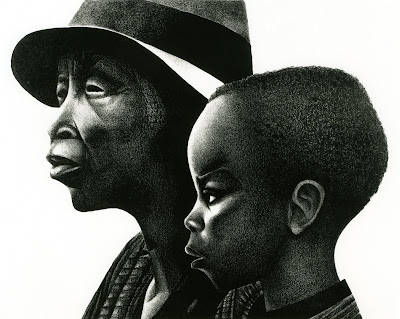Angela Davis
(January 26, 1944 - )

Angela Yvonne Davis was born in Birmingham, Alabama in 1944. She's an American socialist, political activist, and retired professor of the University of California, Santa Cruz - History of Consciousness Department. She also served as the director of school's Feminist Studies department. Her particular research interests include feminism, African American studies and social consciousness.
Angela attended the Elizabeth Irwin High School in Greenwich Village. While there she researched solutions to poverty and racism and becomes intrigued with the Communist Manifesto and communism. (source) She also became a, "vocal activist during the Civil Rights Movement and [she's] a former Black Panther."
"In the 1970s she was a target of COINTELPRO, tried and acquitted of suspected involvement in the Soledad brothers' August 1970 abduction and murder of Judge Harold Haley in Marin County, CA. She was twice a candidate for Vice President on the Communist Party USA ticket during the Reagan era.
Since moving in the early 1990s from communism to reformism she has identified herself as a democratic socialist. [She] is also the founder of Critical Resistance, an organization working to abolish what it calls the prison-industrial complex."
Here are some other important facts about Angela Davis(source):
- September 16, 1963: A church bombing in Birmingham, Alabama kills four girls who Davis knew from her childhood. This greatly impacts Davis and she feels it is the product of a racist, violent society and not just the act of a few angry individuals.
- April, 1968: King is assassinated, which has a large effect on Davis and the organizations in which she is participating. Although King's philosophy differs from Davis', she is devastated by his death and the negative impact is felt throughout the Black community.
- 1969: Davis travels to Cuba which she feels has been completely misrepresented by American propaganda. This affirms her position that the only way to eradicate racism in the United States is to take a socialist route.
- October, 1995: Angela Davis shows her disgust with the exclusion of women in the Million Man March, as she believes it encourages chauvinism in Black activism and the Black community.
- October, 1996: Davis goes to UCLA to speak out in protest against Proposition 209, which would ban affirmative action in University of California schools.
- January 2006: Angela Davis is currently on sabbatical at UC Santa Cruz and continues to tour the world to protest oppression.
Source, Source
Are you a Cut It Out! Girl?!xo
 We'll be at Roots Rockin' Royal II Fashion & Fundraiser tomorrow (2/26) starting at 6pm! 10% of Cut It Out!'s proceeds will go to JAMPACT's Adopt-A-School Program & Haiti Relief Efforts!
We'll be at Roots Rockin' Royal II Fashion & Fundraiser tomorrow (2/26) starting at 6pm! 10% of Cut It Out!'s proceeds will go to JAMPACT's Adopt-A-School Program & Haiti Relief Efforts! 

















